Training like a basketball player can benefit every athlete.
“From a physiological standpoint, basketball is a game of chaos,” says Mubarak “Bar” Malik, director of performance for the New York Knicks. “It’s a fine balance of uncontrollables versus controllables: How an athlete responds to games and practices are uncontrollables and strength training program design is a controllable,” he explains. The exercises in this routine, created by Malik, are great for basketball players because they are "multi-directional in nature, promote core engagement, and incorporate single leg stability, all while efficiently developing strength and power in a safe manner, minimizing the risks of injury during strength training in-season,” says Malik.
And he chose kettlebells over other tools for a reason: “I love their innate design to train the human body in its natural form. They can increase flexibility, strength, power, cardiovascular ability, and work capacity.” Notice that these are all perks that pretty much any athlete can benefit from, whether you play pickup basketball, run marathons, or are looking to supplement your yoga practice.
Work this routine in once or twice a week. Start with this warm-up designed by Malik. If your goal is to build strength, use heavier resistance; for conditioning, go lighter. Perform the moves one after the next as a descending ladder: 10-9-8-7-6-5-3-4-2-1 (do 10 reps of each movement, then 9 of each, then 8 of each, etc.) Rest 1:00 minute between each set. Before starting, set a timer for 30 to 45 minutes and complete as many rounds as possible.
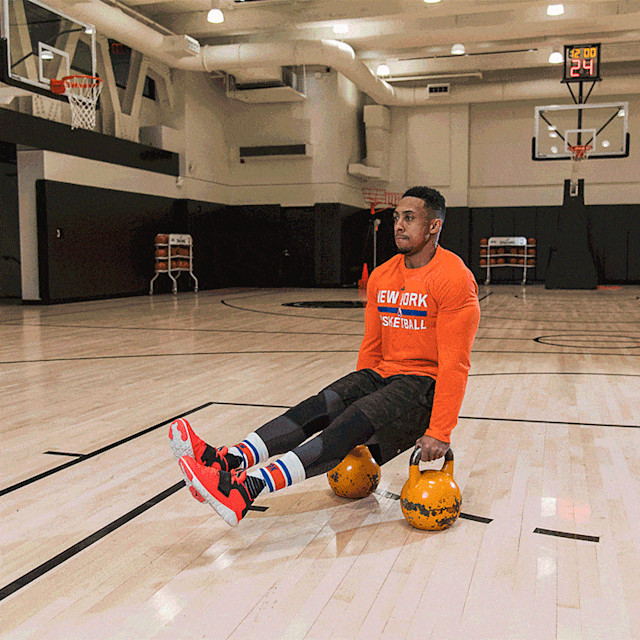
Triceps dips
Position hands shoulder-width apart secured on top of kettlebells. Slide butt forward and extend legs out in front of you. Straighten arms with a little bend in elbows to keep tension on your tricep and off of elbow. Lift legs off the ground (optional), and slowly bend elbows to lower body toward the floor until elbows are at about 90 degrees. Once you reach bottom of position, press down onto the kettlebells, straighten your elbows, and return to starting position.
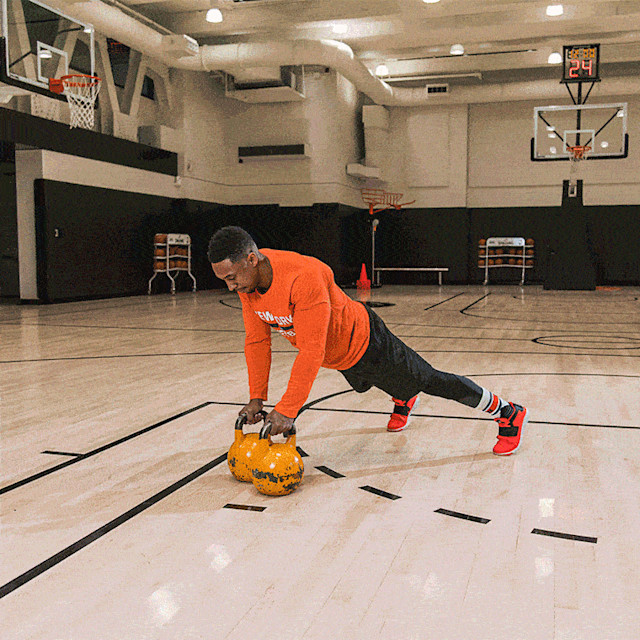
Renegade row
Place two kettlebells on the floor about shoulder-width apart. Start in the top position of a push-up with your hands on the kettlebells. Row one kettlebell up towards the side of your body while balancing on your other hand and feet. Hold for one second at the top and return the kettlebell slowly to the start position. Repeat on other side.
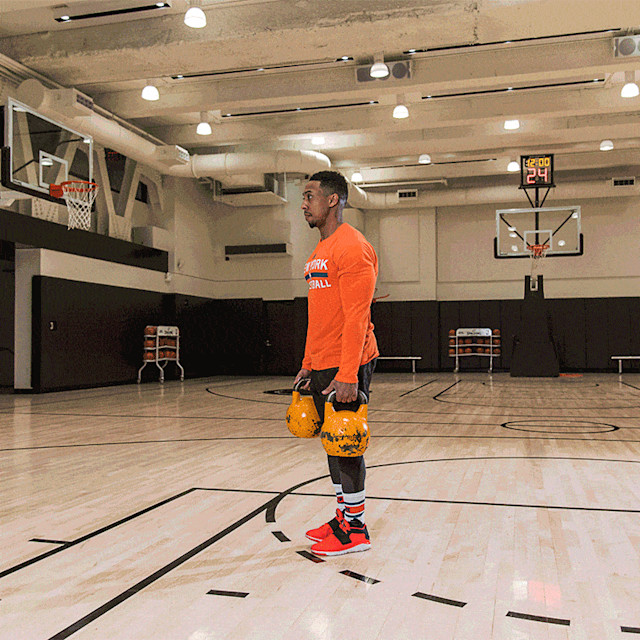
Single leg Romanian deadlift
Stand on one foot while holding a kettlebell with an overhand grip in each hand. Hinge over at the waist, lowering the kettlebells as the non-support legs lifts up behind you. Return to standing position by contracting your hamstrings and glutes. Repeat on opposite side.
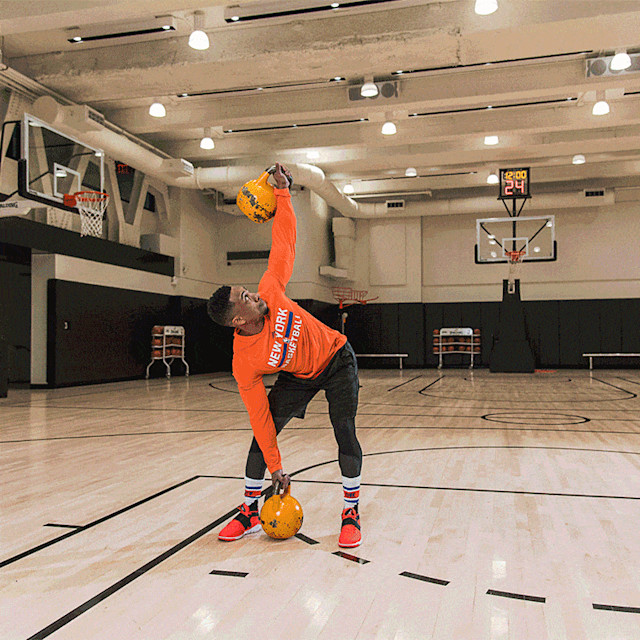
Standing low kettlebell windmill
Start by holding two kettlebells in the racked position (close to the chest). Press one kettlebell up and keep the other kettlebell down in your hand, hanging inside the body. Next, angle the feet 45 degrees away from the arm, holding the kettlebell overhead. Start to bend forward at the waist by pushing back the hip of the rear leg to rear diagonal on same side as the arm overhead. Your arm will stay locked out and extended the entire time. Keep bending forward by pushing back with the hip while keeping back aligned. As you bend forward and return to the starting position, keep eyes on the kettlebell the entire time.
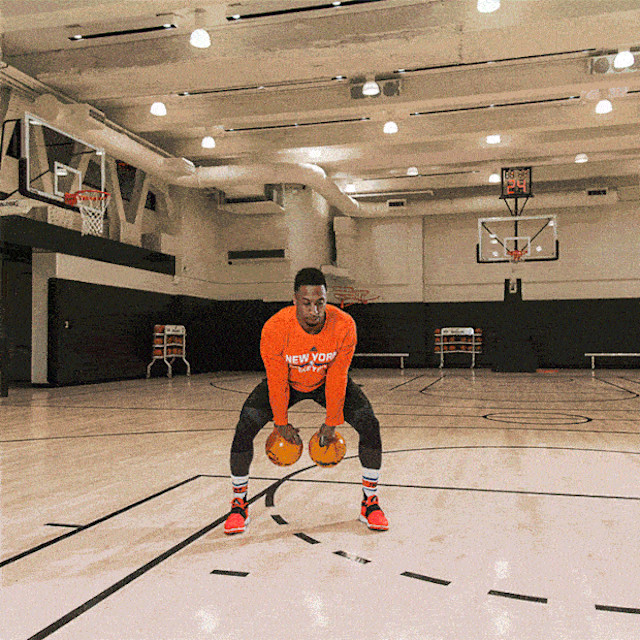
Double clean and press
Stand slightly wider than you would for a kettlebell swing. Rotate the backs of your hands together as you pull kettlebells between your legs. Hike the kettlebells between your legs. Pop the hips, allowing them to fully extend and lock out. Reverse the movement allowing for the most direct route to the racked position. Tighten your glutes and abdominals, pull up your kneecaps, and maintain a vertical forearm. Contract pecs and lats. Pinch shoulder blades together and keep your shoulders tightly down throughout. Visualize cleaning kettlebells to your waist, not your chest. Pause in the racked position. Press kettlebells one at a time with knees locked, the neck neutral, and no back bend.
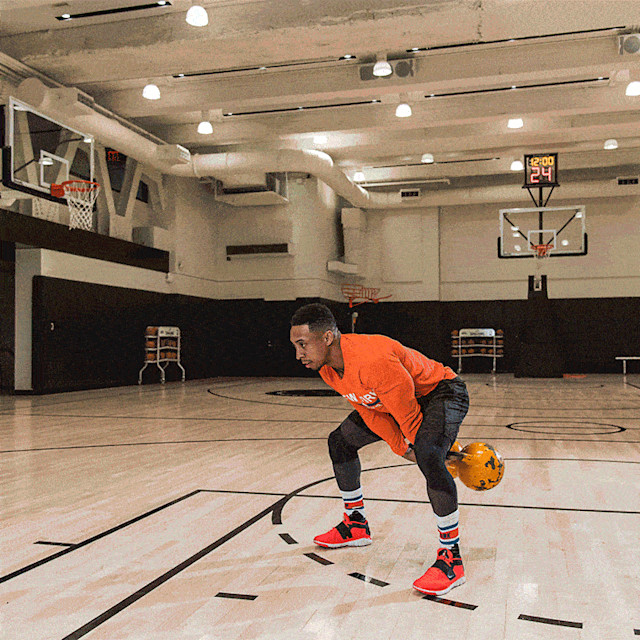
Double arm snatch
Strongly hike both kettlebells back, slightly rotating your forearms inward as they travel behind you. Imagine performing a powerful swing, but then keep the kettlebell close to your body and punch your arm overhead. Your shoulder should not shrug up to accomplish this, and your arm should only guide the kettlebell into the lockout rather than pressing up. You should be gazing straight through the handle of the bell as it passes in front of your face. The kettlebell should land softly, without banging your forearm or jarring your shoulder. Your arm must lock out by your head or ear, wrist straight. Keep body and arm motionless for a second at the top, and your legs must be straight. Begin drop of kettlebell in one smooth motion. Keep it as close to your body as possible, without touching your chest or shoulder. The kettlebell should end up back between your legs with your arms snug against your body.
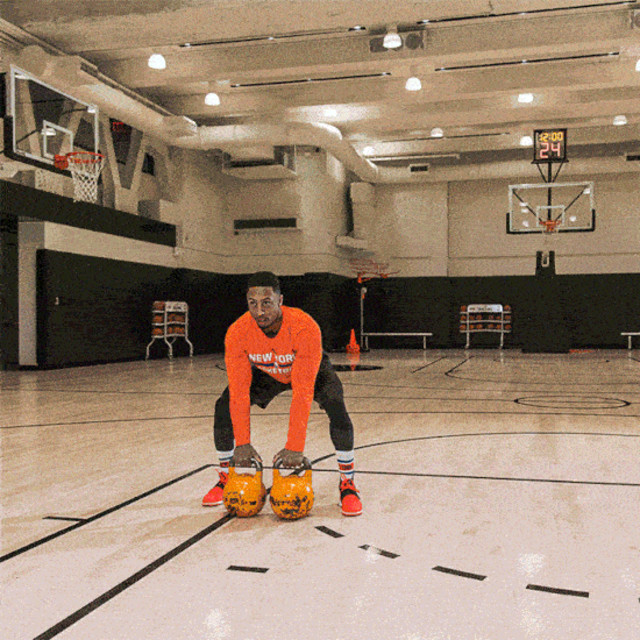
Double arm swing with side step
Stand slightly wider than your two hand swing stance. Rotate handles of the kettlebells so that when you look down at them on the ground, they form a V-shape. Rotate the backs of your hands together as you pull the kettlebells between your legs. Always perform a strong hike pass between your legs. Keep elbows straight. Keep your weight back on your heels throughout the swing. Resist the tendency to be pulled forward that comes with using two kettlebells. Keep your chest up, and look forward at the bottom. Pinch your shoulder blades together and keep your shoulders tightly down throughout. Do not fail to hinge at the hips during the backswing. Once the bell is at chest height (no higher), step to your left side keeping the path of the kettlebell following the midline, allowing it to come down through the legs on the backswing. Repeat to the right side.
